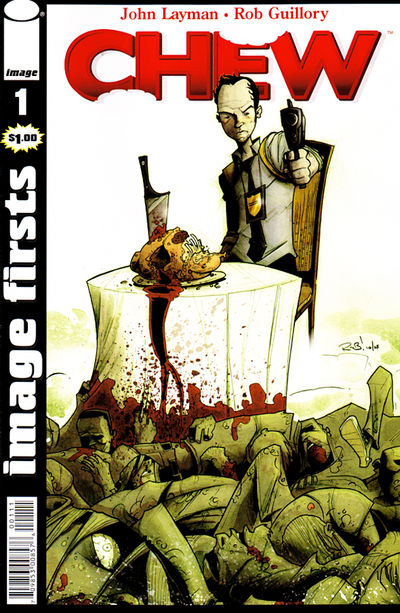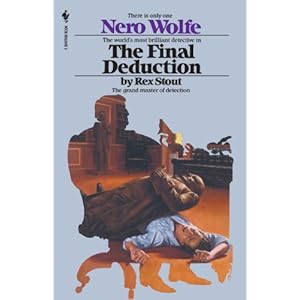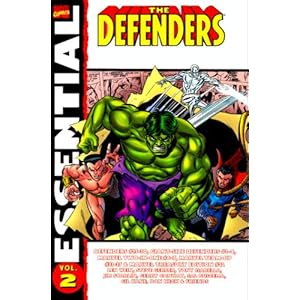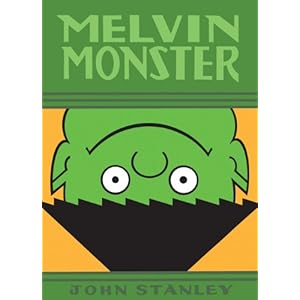
This is sort of an anti-review, because sometimes I feel like writing whatever the heck I want. If John Layman or Rob Guillory stumble across this, apologies, gentlemen, you deserve more professional consideration, but that AdSense link over to the left doesn't give me one-tenth the hits that the ads on my food blog bring. If Brian Michael Bendis stumbles across this, I hope he'll twitter to all his rowdy friends about how the Hipster Pad's Bookshelf is almost 100% linkblog-free!
So I found a new comic shop last week. It's been sitting in a strip mall in a spectacular location in Sandy Springs just north of the perimeter for two years and I never heard of it. It's called Teahouse Comics and, despite supposedly keeping my ears and eyes open in the Atlanta market, they have not done one thing to find me, a potential customer, who, you know, talks about funnybooks on the internet a lot.
Despite desperately needing to fire their marketing department, Teahouse turned out to be a really good comic shop if you're in the market for this sort of comic shop. I noticed it on a Tuesday evening when I was meeting my wife and friends over that way for supper and pulled in. The woman working the place was getting things set up for unpacking and displaying the new funnybooks the next day, and she did a great job making me feel welcome and asking whether she could help me. Considering how many comic shops I've been in where the proprietors could not be bothered getting up from watching either Disney films or porn - well, okay, that's happened twice - or their Magic The Gathering game - that's happened a lot more - just that basic level of service is a good thing.
Teahouse is just one of those Diamond Distributors catalog stores, which seems to be what the hobby wants, but not what I need. They had a heck of a lot of stuff from the last six months of the Previews catalog, and not all of it superhero stuff either, but, you see, I don't want to buy very much that's in that catalog - just 2000 AD and LSH as far as regular titles and I pick those up elsewhere - and I'm looking for shops that have giant collections of incredibly neat treasures that I didn't know existed, or, like the four alleged collections of One Big Happy, I've never actually seen. Giant stacks of Lion, old New Yorker books, the first fifty issues of DWB, embarrassing spiral-bound dot-matrix Thundercats slashfic zines, untranslated Go Nagai and a Julius Knipl book that Ben Katchor himself does not recall writing (which, if you think about it, would both make sense and be the most awesome thing ever). That's what I want in a comic shop.
So Teahouse wasn't it, although it was still a million times better than many, and the woman was nice and I wanted to buy something. That's why I was glad to see that Image Comics has released a series of low-priced reprints of several of their popular comics' first issues to get new readers to try them out. The debut issue of Chew is among them. This is a book that I have seen a lot of my peers reviewing and enjoying, but a combination of budget and increasing malaise with this hobby have left me disinterested in trying new things. Put another way, I have known for more than a year that a book called Chew exists, but not that Teahouse Comics does.
Anyway, it is just as well that I didn't pick up this first issue before now, because I see that there are already some collected editions of Chew, both a low-priced trade paperback and a big, thick hardcover. I would much rather consider buying those than following any more comics. I don't need any more floppy periodicals, but I do need to find out what happens next in this series as soon as possible. This strip is terrific!
It's about a detective who receives psychic information from whatever he eats. The writer explains on page two that apples let him feel the orchard and the pesticides, and hamburgers let him visualize the slaughtered cattle. The only thing this man can eat without getting stuck with all this unwanted information: beets.
The already high concept is ratcheted up further by setting the action in a just-around-the-corner future where the government has banned the consumption of chicken, citing bird flu fears. Yet a conspiracy-minded populace thinks they're not telling the truth, and a poultry-loving populace turns to a black market. Detective Tony Chu and his partner are trying to bust a speakeasy restaurant, but get caught up in a big mess that quickly involves the FDA, a food kingpin and a really heinous serial murderer. What surprises me, looking back on this first chapter, is how integral the comic's two central weird concepts are to the story. That is, because we're set in this oddball world where chicken is illegal, and because Tony Chu has "cibopathic" psychic powers, the story develops the way it does. That's a very neat trick.
I'll also say this, for the benefit of Chew's many champions who don't read my favorite comic: this is just about the most 2000 AD-iest comic that I've ever read that didn't actually run in 2000 AD. It may be spread over an expansive 22 pages, but both in the way Layman and Guillory create their world and very punchily run readers through an introductory adventure in it, I am absolutely reminded of something that Si Spurrier might have written a few years back before he started wasting his time with Silver Surfer comics. In another world, us fanboys are totally pestering Tharg about when we'll get more Lobster Random, Harry Kipling and Chew. That may not make a lot of sense to you, but I can't give this a better compliment. And if you like Chew, why the bejesus are you not reading 2000 AD?
The only thing I'm not entirely keen on is the style that Guillory uses for his character designs. That's by no means a criticism. His pacing and storytelling are really impressive, and there's a double-page spread - the sort of thing that I usually don't like - which just knocked my socks off. I just don't care for the style he's using, and there are plenty of other artists - Steve Roberts and Mark Pingriff come to mind - whose style I don't care for but I look forward to their comics all the same.
As for Detective Chu, well, I'm not entirely sure when I'll be finding out what happens next - things are a little crazy on the home front - but I am definitely looking forward to it. And if you've got a big box of Pippin and TV Century 21 and FOOM and Help! and sixties' Charles Addams paperbacks and a first printing of Guilty, Guilty, Guilty and those giant Little Lulu hardbacks that I once stumbled across for pennies at McKay Books in Chattanooga, swing them by Teahouse Comics in Sandy Springs, would you? Heaven knows I need something to bring me back there. Chew is very highly recommended. Teahouse Comics is recommended over either comic shop in Auburn, Alabama, but it's a long, long way from a Bizarro Wuxtry or a Great Escape or a Beguiling.













